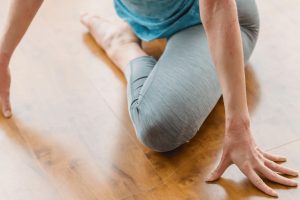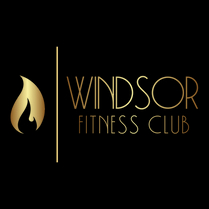
The Importance of Flexibility in Aging
Is it really possible to be flexible over 50? Absolutely! As we age, muscle mass naturally declines and we lose bone density, which leads to reduced flexibility. However, by stretching frequently and staying active, we can reduce this natural decline and improve our flexibility, mobility, and overall movement. It’s important to actively work on flexibility over 50 because the stiffness that comes with age can be particularly limiting. It’s not just a matter of restricted movement; it can also cause pain and discomfort. For example, stiffness in the hip joints and associated muscles (e.g. the psoas) can contribute to a pelvic tilt and lower back pain.
Improving flexibility over 50 brings benefits such as reduced risk of injury, improved range of motion, reduced pain in back, joints, and muscles, improved posture and balance, improved mental well-being, and increased muscle blood flow.
Stretching Exercises for Flexibility Over 50
To improve flexibility over 50, incorporating stretching exercises into your daily routine is crucial. Here are four exercises that can help improve your overall movement:
Supine Wall Straddle
Muscles Targeted: Inner Thighs, Hamstrings
The supine wall straddle is a great beginner-friendly stretch that targets the inner thighs, also known as the adductors. Tightness in these muscles can lead to groin strains and limit lower body movement patterns. To perform this stretch, lie face up with your glutes as close to the wall as possible. Extend your legs up the wall and slowly drop them to the sides until you feel a gentle stretch in your inner thighs. Hold this stretch for 30-60 seconds and repeat it three times. Over time, you can gently push on your legs to increase the stretch.
Book Opener Stretch
Muscles Targeted: Back
The book opener stretch is an effective way to relieve tension in your back, especially the upper back or thoracic spine. This dynamic stretch involves movement and can counteract the effects of sitting at a desk all day. To perform the book opener stretch, lie on your side with your knees bent and both arms stretched out in front, stacked on top of each other. As you exhale, lift the top arm up and over your body towards the floor to open up your chest. Pause for a moment, then return your arms to the starting position. Repeat this stretch 8-12 times on each side.
Samson Stretch
Muscles Targeted: Hips, Legs, Back
The samson stretch is particularly beneficial for targeting the deep muscles in the front of the hips, known as the psoas muscles. These muscles can become stiff from prolonged sitting. To perform the samson stretch, lunge forward with one leg while keeping your back knee on the floor. Extend your arms overhead and gently drive your hips forward until you feel a stretch in the front of your hips. You may want to rest your back knee on a yoga mat or cushion for added comfort.
Dynamic Child’s Pose/Prayer Stretch
Muscles Targeted: Back, Hips
The prayer stretch, also known as the dynamic child’s pose in yoga, is an effective way to stretch the back and open up the hips. From a quadruped (tabletop) position, gently sit back towards your heels. You can either hold this position statically or return to the starting position and repeat it 8-12 times dynamically. This stretch not only promotes hip mobility but also helps stretch out the back. You can also incorporate a rotation, like the thread the needle stretch, from this position.
Types of Stretches
When it comes to stretching, there are two main types: static and dynamic stretches.
Static Stretches
Static stretches involve holding a stretch for a specific duration without additional movement. These stretches are effective for improving flexibility and increasing the length of muscles and tendons. Examples of static stretches include the supine wall straddle and the samson stretch.
Dynamic Stretches
Dynamic stretches involve movement and are often used as part of a warm-up routine before physical activity. These stretches not only improve flexibility but also help increase blood flow to the muscles, preparing them for movement. Examples of dynamic stretches include the book opener stretch and the dynamic child’s pose/prayer stretch.
The Connection Between Flexibility and Mobility
While flexibility is important for maintaining a limber body, it’s equally essential to focus on mobility. Mobility refers to the ability of joints to move freely through their full range of motion. Good mobility is crucial for performing everyday tasks and exercises safely. When muscles become too tight, they can limit mobility and lead to strain or stress on other parts of the body. This can result in altered biomechanics and increased risk of injuries. Therefore, it’s important to work on both flexibility and mobility to maintain overall movement and prevent overuse injuries.
Incorporating Exercise and Activities for Flexibility Over 50
In addition to regular stretching exercises, incorporating other forms of exercise and activities into your routine can further enhance flexibility over 50. Activities like yoga, Pilates, swimming, dancing, and Tai Chi can all help keep your joints and muscles moving. These exercises not only improve flexibility but also contribute to overall strength, balance, and mental well-being.
When starting a new fitness plan, it’s important to take things slow and listen to your body. Gradually increase the intensity and duration of your exercises to avoid strain or injury. Additionally, it’s essential to maintain proper form and technique during exercises to maximize their benefits and reduce the risk of injury.
Although flexibility naturally declines with age, it is possible to maintain and improve flexibility over 50 through regular stretching exercises and incorporating various activities into your routine. Flexibility plays a vital role in performing daily activities, maintaining posture and balance, and preventing pain and discomfort. By focusing on both flexibility and mobility, you can ensure that your joints and muscles move freely, reducing the risk of injuries and enhancing overall movement. Remember to consult with a healthcare professional before starting any new exercise program, especially if you have pre-existing conditions or injuries. Stay active, stretch frequently, and enjoy the benefits of a limber body as you age gracefully.
Windsor Fitness Club Has Regular Yoga, Pilates, and Barre Class that Will Help With Flexibility
WHY HOT YOGA? – Hot Yoga is a mat-based group exercise performed in a heated room in which you move your body into various positions and hold them in order to become more fit and flexible. You will engage your core while strengthening your arms and legs. Your instructor will give you options to use bands, fitness balls, and small weights to help level up your exercise experience. It is both relaxing and challenging at the same time. Yoga can help your breathing, relieve stress, and improve your overall mental health.
WHY HOT BARRE? – Hot Barre is a mat-based group exercise performed in a heated room that is unique to other group fitness activities due to its incorporation of movements derived from ballet. These movements and positions are combined with those drawn from yoga and Pilates. The focus is on the lower body and core, which helps to develop strength and flexibility from the ankles up though the calves, knees, thighs, glutes and abdominals. Your instructor will give you options to use bands, exercise balls, and small weights to help level up your exercise experience.
WHY HOT PILATES? – Hot Pilates is a mat-based group exercise that is performed in a heated room with high energy music. In this class, you will strengthen your core and burn calories with a low-impact, high-intensity, interval workout. Each unique workout session is based on the principles of Pilates using the Tabata method. You will hold movements like planks, side planks, and perform core exercises to build your muscle groups and core strength. Your instructor will give you options to use bands, exercise balls, and small weights to help level up your exercise experience.
Contact us (707-757-4441) for more Information!
Memberships / Class Schedules
—
 About Windsor Fitness Club
About Windsor Fitness Club
We are a positive community of healthy go-getters! We offer state of the art Pilates, Barre, and Yoga Group Classes in a heated environment. Classes are 45 minutes in length, and designed to challenge clients of all fitness levels! Our workouts are innovative, mindful & functional and will help you mentally connect to your muscles and push yourself to new levels of fitness! The music will be turned up and your heart will be pumping! We are excited to help you transform the way you look, feel, and function!
> Learn More

 About Windsor Fitness Club
About Windsor Fitness Club